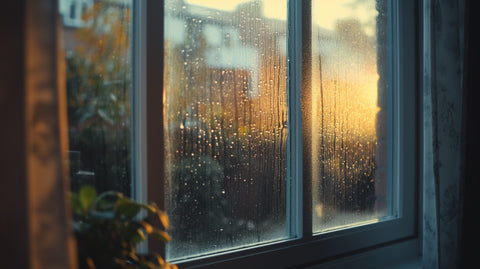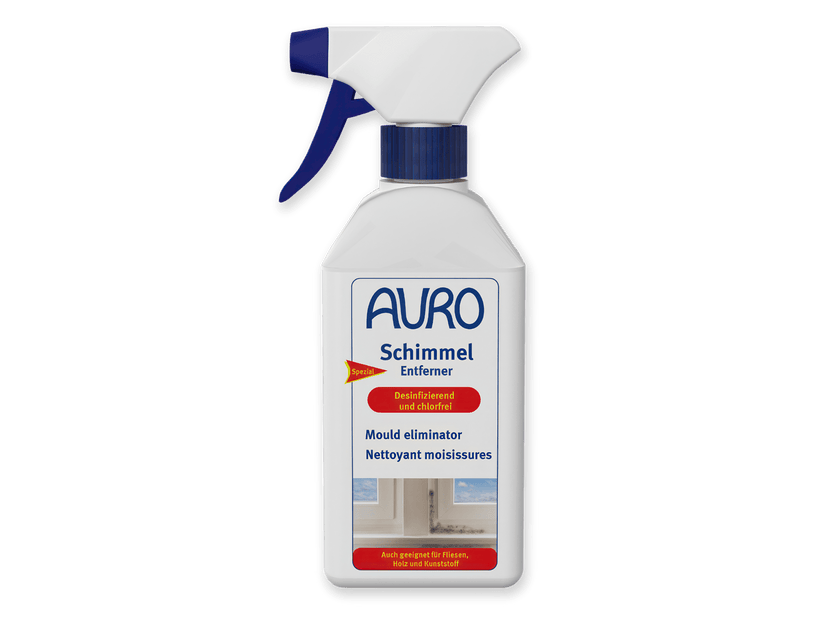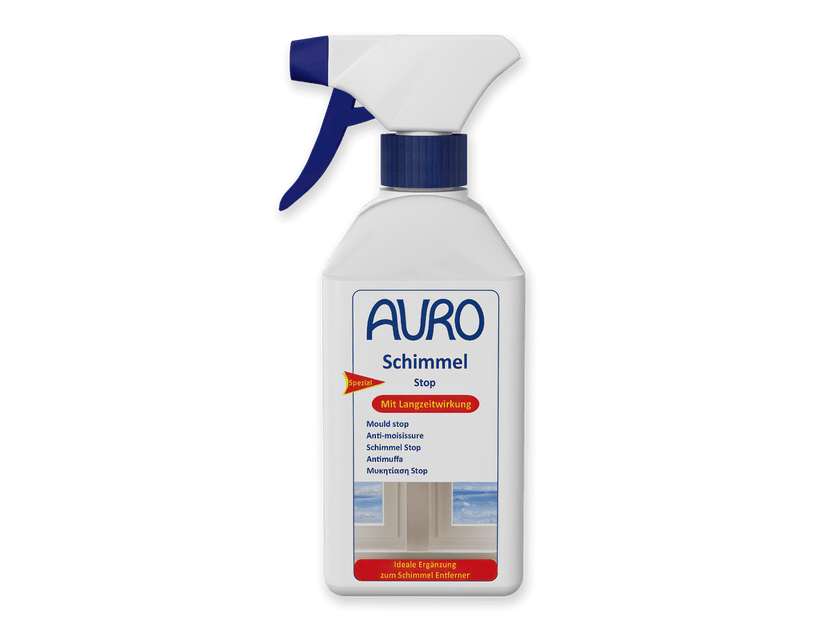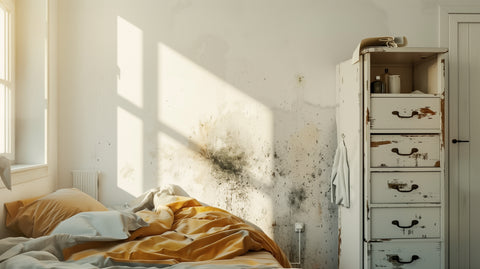Watch out, there’s mould about! Mould can be lurking invisibly in the corners of your bedroom and behind furniture, silently spreading its spores around your sanctuary of slumber.
We want to help you identify what signs to look out for, understand what fuels its growth, how to effectively remove it, and most importantly, how to prevent it from returning.
Understanding the conditions that promote mould growth in bedrooms empowers you to take proactive steps to keep your living environment healthy and mould-free.
Let's shed some light on the world of bedroom mould and equip you with the knowledge to combat it head-on.
Understanding Mould
Have you ever noticed a musty smell in your bedroom that you can't seem to shift? The answer could be due to mould. It thrives on organic materials like fabric, wood, and wallpaper. Mould needs moisture and warmth to grow, making bedrooms with high humidity levels or water leaks ideal breeding grounds. This fungus usually appears as black spots on walls or ceilings, and can also aggravate respiratory issues such as asthma.
Common Causes
Unlike bathrooms that are usually fitted with extraction units, bedrooms often lack proper ventilation and airflow.
If you're noticing bedroom mould, consider factors like lack of ventilation, your sleeping habits, window condensation, and cold walls causing condensation.
These common causes can create the perfect environment for mould growth in your bedroom.
Lack of Ventilation
Inadequate airflow and limited ventilation in bedrooms often leads to high humidity levels, creating an ideal environment for mould growth. Poor air circulation, resulting from closed windows or blocked vents, can trap moisture, fostering mould development.
The absence of proper airflow can cause moisture build-up, stagnant air and condensation on walls and ceilings, leading to mould growth on surfaces.
To help ensure adequate ventilation try keeping windows open, using exhaust fans, and avoiding blocking any vents.
Sleeping / Occupancy
To maintain a mould-free bedroom, consider how sleeping and occupancy habits can contribute to increased humidity levels and potential mould growth. Occupancy in the bedroom raises humidity through breathing, sweating, and body heat. Moisture from uncovered drinks, wet clothes, or damp towels in the room can also fuel mould growth.
During sleep, inadequate ventilation traps moisture, creating a favourable environment for mould. Poor air circulation around furniture or under the bed promotes condensation and mould formation. Sleeping in a poorly ventilated room with closed windows and doors encourages moisture build-up, leading to potential mould issues.
Be mindful of these factors to prevent mould growth and maintain a healthy bedroom environment.
Window Condensation

When warm, moist air inside your bedroom comes into contact with cold window surfaces, window condensation is commonly caused. High humidity levels resulting from activities like showering, cooking, or drying clothes can contribute to this issue.
Poor ventilation in your bedroom can also trap moisture indoors, leading to condensation forming on windows. If not addressed promptly, condensation on bedroom windows can create a breeding ground for mould growth.
Additionally, during colder months when indoor heating is used, window condensation in the bedroom can worsen. To prevent this, consider improving ventilation, using a dehumidifier, or installing double-glazed windows to reduce the temperature difference between indoor and outdoor surfaces.
Cold Walls Condensation
If you notice cold walls in your bedroom accumulating moisture, it could be due to poor insulation and uneven heating. These factors can create a conducive environment for condensation to occur, potentially leading to mould growth.
Addressing these issues promptly is crucial to prevent further damage and maintain a healthy indoor environment.
Poor Wall Insulation
Poor wall insulation can result in cold walls, creating a conducive environment for condensation to form and facilitate mould growth.
Inadequate insulation allows for the build-up of moisture on walls, promoting ideal conditions for mould to thrive.
Bedrooms with poor insulation are more susceptible to condensation, increasing the risk of mould formation.
Addressing this issue is crucial to prevent mould growth, especially in colder climates.
Uneven Heating
Addressing uneven heating in a bedroom is essential to prevent condensation on cold walls, a common factor contributing to mould growth.
Cold walls attract moisture from the air, leading to condensation and promoting mould development. Insufficient heating creates temperature variations that contribute to condensation issues.
Pockets of cold air in bedrooms due to uneven heating can accumulate moisture, fostering mould formation. Ensuring even heating is crucial in preventing mould on bedroom walls.
Potential Health Implications
Exposure to bedroom mould can result in a range of potential health implications that shouldn't be overlooked. The presence of mould in your bedroom can trigger respiratory issues such as coughing, wheezing, and exacerbate symptoms of asthma. Prolonged exposure to bedroom mould may lead to allergies, skin irritation, and sinus congestion.
Particularly concerning is black mould like Stachybotrys, which can produce mycotoxins harmful to human health. Individuals vulnerable to the effects of mould, such as children, the elderly, and those with compromised immune systems, are at higher risk. Symptoms of bedroom mould exposure might include fatigue, headaches, and a general feeling of being unwell.
It's crucial to address mould in your bedroom promptly to avoid these health implications. Taking steps to remove mould and prevent its return is essential for maintaining a healthy living environment.
Ineffective Removal Techniques
You may unknowingly be using ineffective methods to remove mould, such as using vinegar or bleach which may not fully eliminate spores.
Painting over mould without proper treatment can lead to its return through the fresh coat of paint.
Neglecting to address the source of the mould, like high humidity levels, during removal can result in its quick resurgence.
Vinegar / Bleach
Attempting to tackle bedroom mould with vinegar or bleach may seem like a quick fix, but these methods are generally ineffective for thorough removal and long-term prevention. Vinegar and bleach don't penetrate porous surfaces where mould can grow, only removing surface mould temporarily. These solutions fail to address the underlying cause of mould growth in the bedroom, allowing for potential regrowth, especially in damp and humid conditions.
Mould spores can persist in the bedroom after using vinegar or bleach, leading to regrowth. For more effective and long-lasting removal, it's advisable to opt for professional mould removal methods that can thoroughly address the issue and provide better long-term prevention strategies.
Painting Over Mould
If you've tried using vinegar or bleach to address bedroom mould without success, painting over the mould is another ineffective removal technique that fails to tackle the root cause of the issue.
While it may seem like a quick fix, painting over mould doesn't eliminate it. The mould hidden beneath the paint can continue to grow and spread, causing further damage and health risks. Moreover, covering mould with paint can trap moisture, worsening the mould growth and leading to its reappearance.
To ensure a healthy indoor environment, it's crucial to completely remove the mould before painting. Simply painting over the mould without proper cleaning and treatment can result in the mould resurfacing through the fresh paint layers, perpetuating the problem.
Ignoring The Source of the Mould (Humidity)
Addressing high humidity levels in the bedroom is crucial in effectively removing mould and preventing its recurrence. Ignoring the source of mould, like poor ventilation or water leaks, leads to ineffective removal techniques.
Inadequate airflow can trap moisture, creating an ideal environment for mould growth. Merely cleaning visible mould without tackling underlying humidity issues won't stop future infestations.
To remove bedroom mould effectively, you must identify and fix the excess moisture source to prevent its return. Remember, neglecting the root cause of mould, such as high humidity levels, will only result in recurring issues.
Take proactive steps to control humidity in your bedroom to combat mould growth and ensure a healthier living environment.
Effective Mould Removal Techniques
When dealing with mould in your bedroom, consider using professional mould removers like Auro 412 and preventers like Auro 413 for effective results.
These products can help you tackle mould growth efficiently and maintain a mould-free environment in your bedroom.
Take the necessary precautions and follow instructions carefully to ensure the best outcomes.
Professional Mould Remover (e.g. Auro 412)

To effectively remove mould in your bedroom, consider using a professional mould remover like Auro 412, known for its natural and eco-friendly composition. Auro 412 is a peroxide and vinegar-based spray designed to eliminate black mould indoors and outdoors without harsh chemicals. It's safe for skin contact and suitable for various surfaces such as walls, tiles, plastic, and wood.
For optimal results, complement its use with Auro 413 Natural Mould Stop to prevent future mould growth and Auro 327 Natural Anti-Mould Paint for internal walls and ceilings. The chlorine-free and vegan formula contains non-ionic sugar surfactants, 5% ethanol, 4% hydrogen peroxide, and less than 5% of a mild oxygen-based bleaching agent.
Professional Mould Preventer (e.g. Auro 413)

Consider complementing the removal of mould with Auro 413, an eco-friendly and effective professional mould preventer, to ensure long-term protection against black mould in your bedroom.
Auro 413 is chlorine-free and stops black mould growth effectively. It works on various surfaces like tiles, walls, plastic, and wood, especially in damp and poorly ventilated areas. For best results, apply after using Auro 412 Natural Mould Remover and in conjunction with Auro Anti-mould Paint No. 327 for walls.
This vegan and environmentally friendly product contains natural ingredients like water, alcohol, salicylic acid, and sugar surfactants, guaranteeing lasting mould prevention. Use Auro 413 to safeguard your home from the health risks associated with mould growth.
Long Term Mould Prevention Techniques
To prevent mould growth in your bedroom long-term, focus on fixing the root causes like high humidity levels and cold spots. Also consider preventative products such as anti-mould paint.
Fix The Cause - High Humidity & Cold Spots
Addressing high humidity and cold spots in your bedroom is essential for long-term mould prevention. High humidity can lead to condensation on cold surfaces, providing an ideal breeding ground for mould.
To combat this, improve air circulation by opening windows or using a dehumidifier to lower humidity levels and deter mould growth. Additionally, it's crucial to fix any sources of moisture, such as leaks or poor ventilation, to prevent mould in the long run.
Insulating cold spots like windows and exterior walls can help prevent condensation build-up, further reducing the risk of mould formation. Regularly monitor and control indoor humidity levels to create an environment that's inhospitable to mould, safeguarding your bedroom from this potential health hazard.
Anti Mould Paint (e.g. Auro 327)

Improving air quality in your bedroom can be achieved by applying a natural, eco-friendly mould resistant paint like Auro 327. This lime-based paint is breathable, virtually VOC-free, and solvent-free, making it safe for indoor use.
Auro 327 works by creating a high pH environment that prevents mould growth without harsh chemicals. It's easy to apply with a brush or roller, drying to an opaque finish in about 24 hours. Ideal for high-condensation areas, such as bathrooms and windows, this soft white paint covers approximately 10m² per litre.
Made with water, calcium hydroxide, titanium dioxide, mineral fillers, cellulose, and alcohol, Auro 327 is vegan and cruelty-free, offering a long-lasting solution for mould prevention in your home.
Conclusion
Now that you know the dangers of bedroom mould and how to combat it, you can take control of your living environment.
By understanding the causes, implementing effective removal techniques, and practicing long-term prevention methods, you can create a healthier space for yourself.
Stay proactive, stay informed, and say goodbye to bedroom mould for good. Your health and well-being deserve nothing less.






Comments (0)
There are no comments for this article. Be the first one to leave a message!